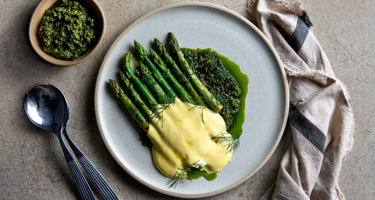
Asparagus is a cherished spring vegetable known for its wonderful earthy flavour and easy use in a wide selection of recipes. Despite its popularity, many home cooks are uncertain about the best ways to prepare and cook it to fully bring out its terrific texture and taste.
This guide will provide you with clear and simple methods for preparing asparagus, from the initial stages of washing and trimming to mastering boiling, grilling, steaming, and other cooking techniques. By the end, you will be able to turn this seasonal vegetable into a central element of your meals, showcasing just how great a properly cooked asparagus is.
How to prepare asparagus for cooking
Asparagus is one of the simplest vegetables to cook, but the magic starts well before it hits the pan, grill, or oven. While both vibrant green asparagus and the delicate white variety require washing and trimming, the methods for preparing the two differ slightly.
Each type has its own considerations, and knowing the right approach for each will help you get the most out of their flavour and texture. But do not worry, it is not complicated. It is just a matter of knowing where to trim, when to peel, and how to treat each type with the care it deserves. Get ready to set the stage for all the fantastic qualities of the asparagus to come through.
Washing and trimming asparagus spears
Preparing green asparagus starts with a good rinse and then a little trimming. Fill a sink or large bowl with cold water. Submerge the spears in the water to remove any dirt, then rinse them under the tap to clean them.
Next comes trimming. Hold each spear at both ends and gently bend it. The asparagus will naturally snap where the tender part meets the tougher, woody section. Discard the hard ends.
If the spears are on the thicker side, peel them using a vegetable peeler, starting from the middle of the spear and working towards the end. Be careful not to peel away the delicate tips. Once the asparagus has been washed, trimmed, and peeled, it is ready for cooking or storing for later use. Easy, simple, and one step closer to a delicious dish.
Preparing white asparagus for cooking
Preparing white asparagus is similar to green asparagus but requires a bit more attention. Start by washing the spears under cold water to remove any dirt or debris. White asparagus has a thicker, tougher skin that can have several layers of fibrous tissue.
To prepare it, carefully peel the outer layer using a vegetable peeler, starting just below the tip and working your way down. Depending on the thickness of the spears, you may need to peel several layers to remove all the fibrous parts. But make sure not to peel too deeply; the inner part of the spear is more delicate and needs a little extra care. Once peeled, trim the tough ends in the same way you would green asparagus.

The different ways to cook asparagus
Asparagus is one of those amazing vegetables that can handle pretty much any cooking method, with each technique highlighting its abilities in different ways.
Roasting brings out a rich flavour with crispy, caramelised tips, while grilling imparts a smoky depth and subtle char, perfect for those of us who love cooking outdoors. Steaming and blanching preserve its natural crispness, allowing the fresh, grassy flavour to shine while keeping the bright green colour intact.
Sometimes, the fastest method is the way to go. Sautéing and stir-frying allow the spears to retain their bite while soaking up the flavours of the oils and seasonings of other ingredients.
With this brief summary, let us explore how these different methods and a few tips and tricks can transform asparagus into a tasty and satisfying part of your meal.
How to roast asparagus in the oven
Roasting asparagus is one of the easiest ways to unlock its rich, caramelised flavour while keeping the texture perfectly tender. The trick? High heat from the oven and a little space for the spears to crisp up.
Preheat your oven to 220 °C (200 °C for a fan-assisted oven). Toss the asparagus with olive oil, coating each spear lightly. Season with salt, pepper, and any additional seasonings you find interesting, like garlic powder or red chilli flakes.
Arrange the asparagus in a single layer on a baking tray lined with parchment paper, leaving space between the spears. This allows the air to circulate around each spear, helping them roast evenly. For green asparagus, roast for about 12–15 minutes; for white asparagus, roast for 15–18 minutes. Thinner spears will cook more quickly, while thicker ones may need an extra minute or two. Remove them from the oven when they are tender and lightly browned.
If you want to test out the roasting method with a twist, try our
where the citrus provides a bright, tangy contrast to the caramelised spears.
How to grill asparagus
Grilling asparagus is a surefire way to add a smoky char and crisp-tender bite to this versatile vegetable. It is quick, easy, and perfect for outdoor cooking or a stove-top grill pan.
Start by gently tossing the asparagus with olive oil, evenly coating each spear to prevent it from sticking to the grill. Season with salt and pepper to taste. Then, preheat your grill to medium heat, around 230 °C. This temperature is ideal for cooking the asparagus thoroughly without burning. Lay the asparagus across the grill bars so they do not fall through.
Grill green asparagus for about 6–8 minutes or white asparagus for 8–10 minutes, turning them halfway through to cook evenly and develop a nice, smoky char. The asparagus is done when it becomes tender and has light grill marks, with a crispy exterior and a soft in the centre.
If grilling your asparagus sounds intriguing, try our delicious
which introduces bold flavours and a creamy, nutty twist to the classic grilled asparagus.
How to boil asparagus
Boiling asparagus is a simple way to achieve tender, vibrant spears with little effort. It is a go-to method for many, especially if you want the natural flavour of asparagus to shine.
Fill a large pot with water and bring it to a rolling boil. Add a pinch of salt. Once the water is boiling, carefully add the asparagus, ensuring the spears are fully submerged. Cook them uncovered for 3–5 minutes for green asparagus or 5–7 minutes for white asparagus, depending on their thickness. Thinner spears will cook faster, while thicker ones may need an extra minute or two.
Pierce a spear with a fork to see if it has finished cooking. The asparagus should be tender but still have a slight bite. If you prefer softer asparagus, leave it in for another minute.
When cooked to your liking, use tongs to remove the spears or drain them in a colander to remove any excess water, then transfer the spears to a bowl of ice water. The ice water stops the cooking process and preserves their crispness. After a few minutes, remove them from the ice water and pat dry with a clean kitchen or paper towel.
The best way to steam asparagus
Steaming is a fantastic way to cook asparagus. Doing so preserves its vibrant colour, delicate texture, and fresh, earthy flavours.
Bring about 3 cm of salted water to a boil in a pot with a steamer basket. Lay the asparagus in a single layer in the basket. If all of the asparagus do not fit, steam them in batches, so they cook evenly.
Cover the pot and steam the green asparagus for about 3 minutes, or 4–5 minutes for white asparagus. As with most ways of cooking asparagus, they should be tender but still have a slight bite. If you do not have a steamer basket, you can create one by placing a heatproof plate or colander over the pot and following the same steaming instructions.
The best way to blanche asparagus
Bring a large pot of salted water to a rapid boil to blanch asparagus. Add the asparagus and let it simmer for 1–2 minutes for green asparagus or 3–4 minutes for white asparagus. This brief cooking time softens the spears slightly while helping them retain a firmer texture compared to boiling.
Immediately transfer the asparagus to a bowl of ice water. The cold water prevents the spears from overcooking by rapidly cooling them. Once cooled, remove them from the water and pat dry to get rid of excess moisture, which could make them soggy.
Sautéing and stir-frying asparagus
Sautéing and stir-frying are two of the fastest methods for cooking asparagus, each delivering tender, flavourful spears with a satisfying bite. They do, however, differ in technique and the type of fat best suited for each. Both green and white asparagus can be prepared using these methods, though when selecting them, thin spears are ideal as they cook more evenly and quickly. Thicker spears can also be used but may require slightly longer cooking times.
Sautéing involves cooking asparagus over medium heat with a touch of oil or butter. The goal is to get a slight browning while keeping the texture crisp-tender. Butter adds creaminess and richness, but remember to use moderate heat to prevent burning. For a more natural flavour, use rapeseed or olive oil. Sauté green asparagus for 3–5 minutes or white asparagus for 5–7 minutes, stirring occasionally to cook evenly.
Stir-frying takes things up a notch. It is a more intense method involving high heat and continuous movement in the pan. A wok or a large frying pan works best for stir-frying, as it allows for plenty of space to toss the asparagus.
Cut the spears diagonally into 2–3 cm pieces to increase surface area for better oil and seasoning absorption. Adding a small amount of oil, such as rapeseed or peanut oil, is best, as they can withstand high temperatures without burning. Stir-fry green asparagus for about 3–4 minutes and white asparagus for about 4–5 minutes.
Can you eat asparagus raw?
Yes, asparagus can indeed be eaten raw, both green and white. Raw green asparagus tends to have a mild, slightly grassy taste, similar to raw snap peas or green beans, with a subtle sweetness. On the other hand, white asparagus has a more subtle, slightly bitter taste than its green counterpart. Its texture is also more tender, and the flavour is less intense.
If you are wondering how to use raw asparagus, try slicing the spears thinly to add to salads or use them as a crunchy topping for dishes like grain bowls. Raw asparagus also works well in fresh salsas or as part of a vegetable crudité platter, where its crispness contrasts nicely with other softer veggies.

How long does it take to cook asparagus?
Now that we have explored the techniques for preparing green asparagus, it is clear that each cooking method has its own ideal cooking time for optimal results. The following table provides a quick overview of these recommended cooking times for each method, offering a handy reference for achieving perfectly cooked asparagus every time.
| Cooking Method | Time |
|---|---|
| Roasting | 12–15 minutes at 220 °C |
| Grilling | 6–8 minutes on medium heat |
| Boiling | 3–5 minutes |
| Steaming | 3 minutes |
| Blanching | 1–2 minutes |
| Sautéing | 3–5 minutes |
| Stir-frying | 3–4 minutes |
How long does it take to cook white asparagus?
White asparagus can be prepared using the same cooking methods as green asparagus, but its firmer texture and more delicate flavour mean that adjustments are needed. It takes longer to cook, as the spears are thicker and need more time to become tender. While it can be swapped for green asparagus in most recipes, the differences in texture and taste should be considered, especially in dishes where green asparagus's fresh, grassy flavour is key. To help with cooking times, the table below outlines the ideal timings for each method.
| Cooking Method | Time |
|---|---|
| Roasting | 15–18 minutes at 220 °C |
| Grilling | 8–10 minutes on medium heat |
| Boiling | 5–7 minutes |
| Steaming | 4-5 minutes |
| Blanching | 3–4 minutes |
| Sautéing | 5–7 minutes |
| Stir-frying | 4–5 minutes |
Find the best asparagus recipes to cook
Now that we have covered how to prepare and cook asparagus, it is time to put that knowledge to the test. Whether you are looking for simple roasted asparagus, classic preparations, or creative ways to cook it, there are plenty of options to explore.
For a collection of ideas using both types, asparagus recipes are a great place to start. If you are focusing on green asparagus, green asparagus recipes provide a range of options suited to its fresh taste and tender texture. For those who prefer white asparagus, white asparagus recipes offer recipes that work well with its delicate flavour.
If you want to learn more about asparagus beyond cooking, all you need to know about asparagus covers everything from selecting the best spears to storing them properly.




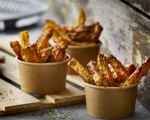


















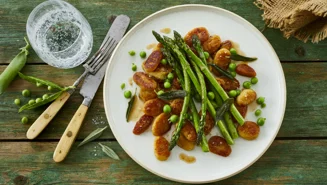
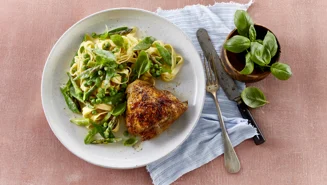
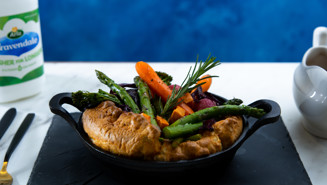&format=webp)




&format=webp)











